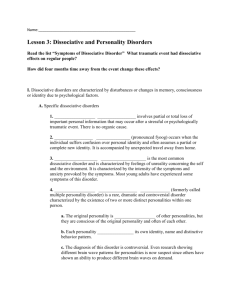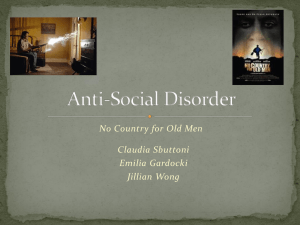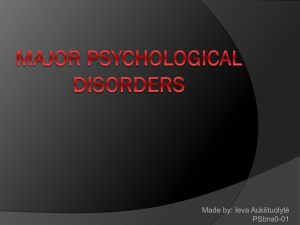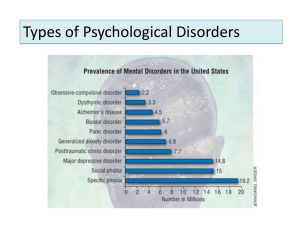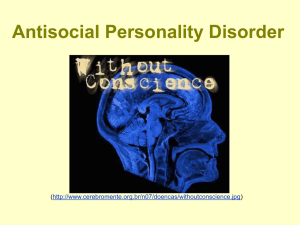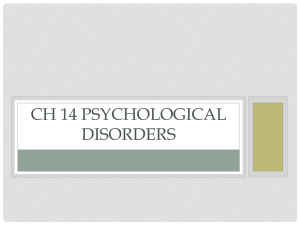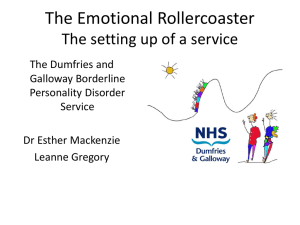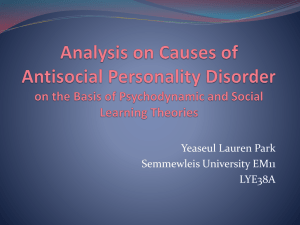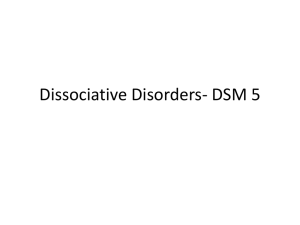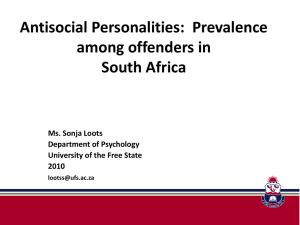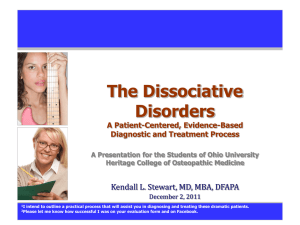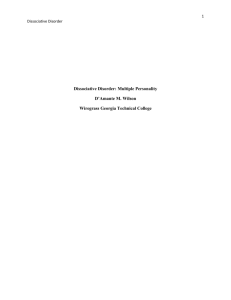a PowerPoint presentation of Module 51
advertisement
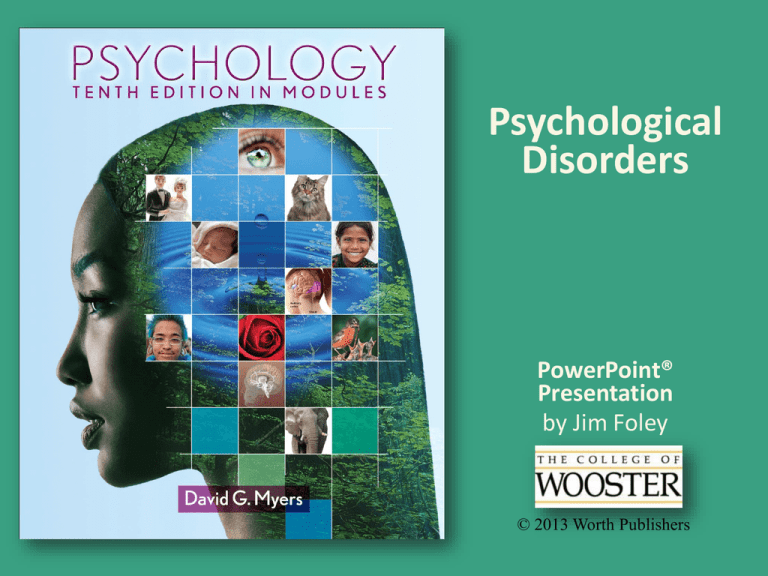
Psychological Disorders PowerPoint® Presentation by Jim Foley © 2013 Worth Publishers Module 51: Dissociative, Personality, and Eating Disorders Dissociative Disorders Examples: Dissociation refers to a separation of conscious awareness from thoughts, memory, bodily sensations, feelings, or even from identity. Dissociation can serve as a psychological escape from an overwhelmingly stressful situation. A dissociative disorder refers to dysfunction and distress caused by chronic and severe dissociation. Dissociative Amnesia: Loss of memory with no known physical cause; inability to recall selected memories or any memories Dissociative Fugue “Running away” state; wandering away from one’s life, memory, and identity, with no memory of these Dissociative Identity Disorder (D.I.D.) Development of separate personalities Dissociative Identity Disorder (D.I.D.) formerly “Multiple Personality Disorder” In the rare actual cases of D.I.D., the personalities: are distinct, and not present in consciousness at the same time. may or may not appear to be aware of each other. Alternative Explanations for D.I.D. Dissociative “identities” might just be an extreme form of playing a role. D.I.D. in North America might be a recent cultural construction, similar to the idea of being possessed by evil spirits. Cases of D.I.D. might be created or worsened by therapists encouraging people to think of different parts of themselves. D.I.D., or DID Not? Evidence that D.I.D. is Real Different personalities have involved: different brain wave patterns. different left-right handedness. different visual acuity and eye muscle balance patterns. Patients with D.I.D. also show heightened activity in areas of the brain associated with managing and inhibiting traumatic memories. Criticisms of Dissociative Identity Disorder include all of the following, EXCEPT: A. there is no evidence that humans can experience a divided consciousness. B. symptoms of the disorder are most dramatic after the patient has begun therapy. C. in some countries, the disorder is nonexistent. D. children who have endured extreme traumas, such as watching a parent’s murder, do not develop the disorder. Eating Disorders Anorexia nervosa Bulimia nervosa Binge-eating disorder Anorexia Nervosa Bulimia Nervosa Binge-Eating Disorder These may involve: unrealistic body image and extreme body ideal. a desire to control food and the body when one’s situation can’t be controlled. cycles of depression. health problems. Definition Prevalence Compulsion to lose weight, 0.6 percent coupled with certainty about meet criteria at being fat despite being 15 percent some time or more underweight during lifetime Compulsion to binge, eating large amounts fast, then purge by losing 1.0 percent the food through vomiting, laxatives, and extreme exercise Compulsion to binge, followed by 2.8 percent guilt and depression Eating Disorders: Associated Factors Family factors: having a mother focused on her weight, and on child’s appearance and weight negative self-evaluation in the family for bulimia, if childhood obesity runs in the family for anorexia, if families are competitive, high-achieving, and protective Cultural factors: unrealistic ideals of body appearance Lindsey is extremely afraid of becoming obese even though she is underweight. She often checks her body in the mirror for any signs of fat and refuses to eat most foods because she insists they are fatty or high in calories. Lindsey most clearly demonstrates symptoms of: A. B. C. D. excess PYY. bulimia nervosa. an abnormally high set point. anorexia nervosa. Over the past 50 years, the incidence of anorexia nervosa has steadily increased. This is most clearly attributable to: A. cultural ideals of beauty that increasingly encourage thinness. B. increasing levels of childhood sexual abuse. C. the onset of adolescence at increasingly younger ages. D. the decreasing emphasis on maintaining stable marriages. Personality Psychopathology DSM V Personality Disorder Types • Six personality disorder types: – – – – – – Schizotypal Borderline Avoidant Narcissistic Obsessive-compulsive Antisocial • Diagnosis involves “matching” individual with DSM-5 description of disorder • Originally 10 disorders identified in DSM-IV-TR; clinical evidence did not support four of these: – Paranoid, schizoid, histrionic, and dependent personality disorders Personality Disorder Trait Specified (cont’d.) • Five-domain trait dimensional diagnostic system for assessing personality disorders – Trait: specific personality characteristic possessed by individual; may be organized around a domain – Existence of one or more domain traits that impair interpersonal functioning is sufficient to indicate personality disorder Personality Disorder Trait Specified (cont’d.) Antisocial Personality Disorder [APD] Antisocial personality disorder refers to acting impulsively or fearlessly without regard for others’ needs and feelings. Criminality is not an essential component of antisocial behavior The diagnostic criteria include a pattern of violating the rights of others since age 15, including three of these: Deceitfulness Disregard for safety of self or others Aggressiveness Failure to conform to social norms Lack of remorse Impulsivity and failure to plan ahead Irritability Irresponsibility regarding jobs, family, and money Low levels of anxiety are most characteristic of: A. B. C. D. antisocial personality disorder. dissociative identity disorder. obsessive-compulsive disorder. paranoid schizophrenia. Which Kids May Develop APD as Adults? About half of children with persistent antisocial behavior develop lifelong APD. Which kids are at risk? Psychological factors: those who in preschool were impulsive, uninhibited, unconcerned with social rewards, and low in anxiety. those who endured child abuse, and/or inconsistent, unavailable caretaking. Biological APD Risk Factors Antisocial or unemotional biological relatives increases risk. Some associated genes have been identified. Risk factors include body-based fearlessness, lower levels of stress hormones, and low physiological arousal in stressful situations such as awaiting receiving a shock. Fear conditioning is impaired. Reduced prefrontal cortex tissue leads to impulsivity. Substance dependence is more likely. Antisocial Crime If antisocial personality disorder is not a full picture of most criminal activity, what can we say about people who commit crime, especially violent crime? Biosocial roots of crime: birth complications and poverty combine to increase risk. Biosocial Roots of Crime: The Brain People who commit murder seem to have less tissue and activity in the part of the brain that suppresses impulses. Other differences include: less amygdala response when viewing violence. an overactive dopamine reward-seeking system.
